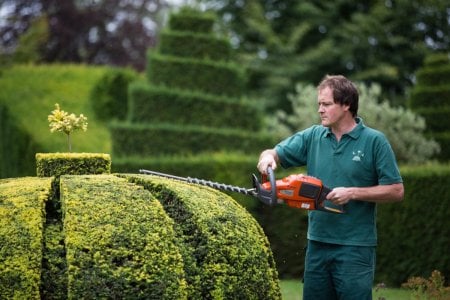Discover royal secrets: How to banish slugs and snails for good with these four tips!
- Replies 2
As the sun begins to linger longer in the sky and the soil warms to the touch, Australian gardeners are rolling up their sleeves for the growing season ahead.
However, with the promise of blooming flowers and bountiful harvests comes the inevitable battle against garden pests, particularly the notorious duo of slugs and snails that can wreak havoc on your carefully cultivated plants, leaving a trail of destruction in their wake.
But fear not, green-thumbed friends! Royal Gardener Jack Stooks, with over two decades of experience tending to the Royal Household's Highgrove House, has shared his wisdom to help you protect your garden sanctuary.
Mr Stooks revealed that while slugs and snails are different, there are multiple ways to catch the two together.
He shared four methods of keeping the regal gardens free from these slimy invaders.

DIY fermented yeast drink trap
Mr Stooks suggested that although it will need regular replenishment and renewal, creating homemade fermented yeast drink traps and positioning them in the garden could effectively address both pests.
These traps, crafted by pouring fermented yeast drink into small dishes, jars, or bowls, lure slugs and snails with their scent.
‘With snails and slugs, it is pretty much the same. You can catch both with fermented yeast drink traps, which you can buy ready-made online or make your own,’ Mr Stooks said.
‘They can be expensive, but I would suggest making your own with jam jars. What you do is dig it down into the ground so the top is level with the soil. Into that, you put in a quarter of the jam jar, and fill up with the fermented drink.’
To create your own, simply mix water with a pinch of sugar and dried yeast.
‘The slugs will be attracted to the yeasty odours, which will make them travel down the jar, which can be covered slightly using a rock. Often you'll find a few the next day or leave it for a few days, before emptying them out into the compost and redoing it with fresh drink,’ Mr Stooks explained.
‘However, this won't work with snails. If you are trying to catch snails, you are going to need a bigger glass jar, as you need a bigger opening.’
‘The only problem with leaving a bigger opening is that once it rains, it washes down the drink, so top up and change the drink regularly if you are trying to catch them both,’ he added.
Nighttime patrols with a torch
Although the traps could serve as a viable remedy, Mr Stooks also disclosed that one of the most efficient methods for eliminating snails involves venturing out at night with a torch and manually collecting them.
He recommended this as employing the traps also carries the risk of inadvertently capturing beneficial garden insects along with the snails.
‘Ideally, you can do this at night and go around with a torch as this is when they are more prevalent,’ he advised.
‘These types of animals are attracted to the light from the torch, which makes them easier to catch.’
Organic gardening
According to Mr Stooks, practising organic gardening methods will also encourage the return of wildlife to our garden while naturally discouraging snails and slugs from consuming your plants.
‘These animals will naturally deter snails and slugs from eating your plants as they eat them,’ he explained.
However, what is organic gardening? The Royal Horticulture Society defines it as ‘cultivation systems which make minimal use of manufactured chemical substances’ with the perspective of ‘emphasising the interdependence of life forms’.
Copper collaring
Lastly, Mr Stooks recommended using copper collars as a physical barrier in a method known as ‘copper collaring’.
These can be placed around the base of plants or the rims of pots to deter slugs and snails, which experience an unpleasant reaction when their bodies come into contact with copper.
According to him, you can use this ‘If you have pots and it's easy enough to put a collar around’.
‘However, I do find this is quite a monotonous way of doing things. Fermented drink traps are the best and easiest way of dealing with slugs in the garden, but it's good if people can have a few different methods to try and see what works best for them,’ Mr Stooks added.
As gardeners seek effective solutions to combat pests like slugs and snails, the insights shared by Mr Stooks shed light on practical strategies for managing these pesky invaders.
However, while addressing pest problems, it's crucial to consider the broader impact on garden biodiversity and the delicate balance of nature.
This perspective on sustainable gardening aligns with ongoing discussions surrounding another prevalent issue in Australian gardens, underscoring the importance of holistic approaches to gardening challenges.
 Have you tried any of these methods in your own garden? Do you have any other tried-and-true strategies for keeping pests at bay? Share your experiences and tips in the comments below.
Have you tried any of these methods in your own garden? Do you have any other tried-and-true strategies for keeping pests at bay? Share your experiences and tips in the comments below.
However, with the promise of blooming flowers and bountiful harvests comes the inevitable battle against garden pests, particularly the notorious duo of slugs and snails that can wreak havoc on your carefully cultivated plants, leaving a trail of destruction in their wake.
But fear not, green-thumbed friends! Royal Gardener Jack Stooks, with over two decades of experience tending to the Royal Household's Highgrove House, has shared his wisdom to help you protect your garden sanctuary.
Mr Stooks revealed that while slugs and snails are different, there are multiple ways to catch the two together.
He shared four methods of keeping the regal gardens free from these slimy invaders.

Royal Gardener Jack Stooks shared his four methods of getting rid of slugs and snails in the garden. Credits: X / @jackstooks
DIY fermented yeast drink trap
Mr Stooks suggested that although it will need regular replenishment and renewal, creating homemade fermented yeast drink traps and positioning them in the garden could effectively address both pests.
These traps, crafted by pouring fermented yeast drink into small dishes, jars, or bowls, lure slugs and snails with their scent.
‘With snails and slugs, it is pretty much the same. You can catch both with fermented yeast drink traps, which you can buy ready-made online or make your own,’ Mr Stooks said.
‘They can be expensive, but I would suggest making your own with jam jars. What you do is dig it down into the ground so the top is level with the soil. Into that, you put in a quarter of the jam jar, and fill up with the fermented drink.’
To create your own, simply mix water with a pinch of sugar and dried yeast.
‘The slugs will be attracted to the yeasty odours, which will make them travel down the jar, which can be covered slightly using a rock. Often you'll find a few the next day or leave it for a few days, before emptying them out into the compost and redoing it with fresh drink,’ Mr Stooks explained.
‘However, this won't work with snails. If you are trying to catch snails, you are going to need a bigger glass jar, as you need a bigger opening.’
‘The only problem with leaving a bigger opening is that once it rains, it washes down the drink, so top up and change the drink regularly if you are trying to catch them both,’ he added.
Nighttime patrols with a torch
Although the traps could serve as a viable remedy, Mr Stooks also disclosed that one of the most efficient methods for eliminating snails involves venturing out at night with a torch and manually collecting them.
He recommended this as employing the traps also carries the risk of inadvertently capturing beneficial garden insects along with the snails.
‘Ideally, you can do this at night and go around with a torch as this is when they are more prevalent,’ he advised.
‘These types of animals are attracted to the light from the torch, which makes them easier to catch.’
Organic gardening
According to Mr Stooks, practising organic gardening methods will also encourage the return of wildlife to our garden while naturally discouraging snails and slugs from consuming your plants.
‘These animals will naturally deter snails and slugs from eating your plants as they eat them,’ he explained.
However, what is organic gardening? The Royal Horticulture Society defines it as ‘cultivation systems which make minimal use of manufactured chemical substances’ with the perspective of ‘emphasising the interdependence of life forms’.
Copper collaring
Lastly, Mr Stooks recommended using copper collars as a physical barrier in a method known as ‘copper collaring’.
These can be placed around the base of plants or the rims of pots to deter slugs and snails, which experience an unpleasant reaction when their bodies come into contact with copper.
According to him, you can use this ‘If you have pots and it's easy enough to put a collar around’.
‘However, I do find this is quite a monotonous way of doing things. Fermented drink traps are the best and easiest way of dealing with slugs in the garden, but it's good if people can have a few different methods to try and see what works best for them,’ Mr Stooks added.
As gardeners seek effective solutions to combat pests like slugs and snails, the insights shared by Mr Stooks shed light on practical strategies for managing these pesky invaders.
However, while addressing pest problems, it's crucial to consider the broader impact on garden biodiversity and the delicate balance of nature.
This perspective on sustainable gardening aligns with ongoing discussions surrounding another prevalent issue in Australian gardens, underscoring the importance of holistic approaches to gardening challenges.
Key Takeaways
- Royal Gardener Jack Stooks recommended four methods to get rid of slugs and snails, including homemade fermented yeast drink traps.
- According to him, using fermented yeast drink trap attracts the pests with their odour, but needs regular top-up and refreshing.
- He also suggested going out at night with a torch as an effective way to collect snails, which are more active and easier to spot then.
- Mr Stooks also said that organic gardening practices invite wildlife that naturally prey on slugs and snails, while copper collaring can protect individual plants.








